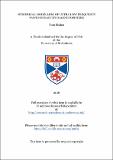Files in this item
Numerical modelling of ultra low frequency waves in Earth's magnetosphere
Item metadata
| dc.contributor.advisor | Wright, Andrew Nicholas | |
| dc.contributor.author | Elsden, Tom | |
| dc.coverage.spatial | 168 | en_US |
| dc.date.accessioned | 2018-07-23T15:42:25Z | |
| dc.date.available | 2018-07-23T15:42:25Z | |
| dc.date.issued | 2016-06-24 | |
| dc.identifier.uri | https://hdl.handle.net/10023/15663 | |
| dc.description.abstract | Ultra Low Frequency (ULF) waves are a ubiquitous feature of Earth's outer atmosphere, known as the magnetosphere, having been observed on the ground for almost two centuries, and in space over the last 50 years. These waves represent small oscillations in Earth's magnetic field, most often as a response to the external influence of the solar wind. They are important for the transfer of energy throughout the magnetosphere and for coupling different regions together. In this thesis, various features of these oscillations are considered. A detailed background on the history and previous study of ULF waves relevant to our work is given in the introductory chapter. In the following chapters, we predominantly use numerical methods to model ULF waves, which are carefully developed and thoroughly tested. We consider the application of these methods to reports on ground and spaced based observations, which allows a more in depth study of the data. In one case, the simulation results provide evidence for an alternative explanation of the data to the original report, which displays the power of theoretical modelling. An analytical model is also constructed, which is tested on simulation data, to identify the incidence and reflection of a class of ULF wave in the flank magnetosphere. This technique is developed with the aim of future applications to satellite data. Further to this, we develop models both in Cartesian and dipole geometries to investigate some of the theoretical aspects of the coupling between various waves modes. New light is shed on the coupling of compressional (fast) and transverse (Alfvén) magnetohydrodynamic (MHD) wave modes in a 3D dipole geometry. Overall, this thesis aims to develop useful numerical models, which can be used to aid in the interpretation of ULF wave observations, as well as probing new aspects of the existing wave theory. | en_US |
| dc.language.iso | en | en_US |
| dc.publisher | University of St Andrews | |
| dc.relation | T. Elsden and A. N. Wright. The use of the Poynting vector in interpreting ULF waves in magnetospheric waveguides. Journal of Geophysical Research (Space Physics), 120: 166{186, January 2015. doi: 10.1002/2014JA020748 | en_US |
| dc.relation | T. Elsden, A. N. Wright, and M. D. Hartinger. Deciphering satellite observations of compressional ulf waveguide modes. Journal of Geophysical Research: Space Physics, pages n/a{n/a, 2016. ISSN 2169-9402. doi: 10.1002/2016JA022351. URL http://dx. doi.org/10.1002/2016JA022351. 2016JA022351. | en_US |
| dc.subject | Magnetohydrodynamics | en_US |
| dc.subject | Space plasma physics | en_US |
| dc.subject | Magnetosphere | en_US |
| dc.subject | Numerical simulations | en_US |
| dc.subject | ULF waves | en_US |
| dc.subject.lcc | QC809.M35E6 | |
| dc.subject.lcsh | Magnetohydrodynamics--Mathematical models | en |
| dc.subject.lcsh | Space plasmas--Mathematical models | en |
| dc.subject.lcsh | Magnetospheric radio wave propagation--Mathematical models | en |
| dc.title | Numerical modelling of ultra low frequency waves in Earth's magnetosphere | en_US |
| dc.type | Thesis | en_US |
| dc.contributor.sponsor | Science and Technology Facilities Council (STFC) | en_US |
| dc.type.qualificationlevel | Doctoral | en_US |
| dc.type.qualificationname | PhD Doctor of Philosophy | en_US |
| dc.publisher.institution | The University of St Andrews | en_US |
This item appears in the following Collection(s)
Items in the St Andrews Research Repository are protected by copyright, with all rights reserved, unless otherwise indicated.

